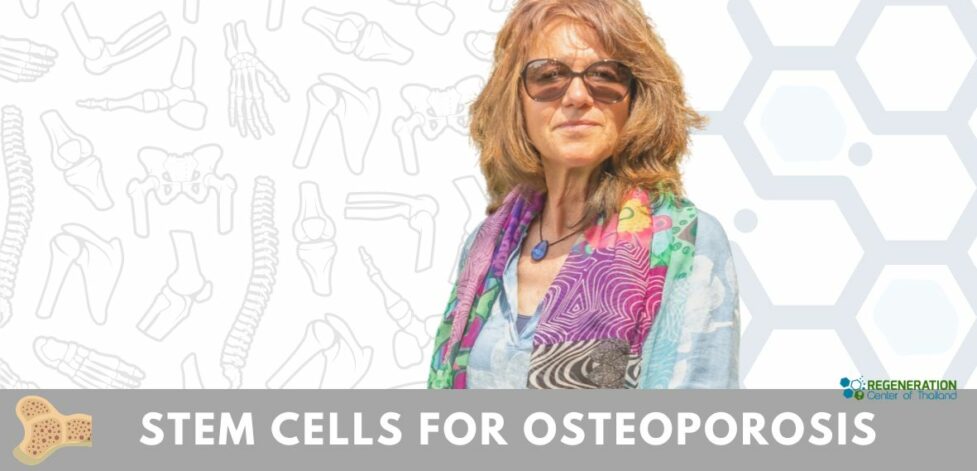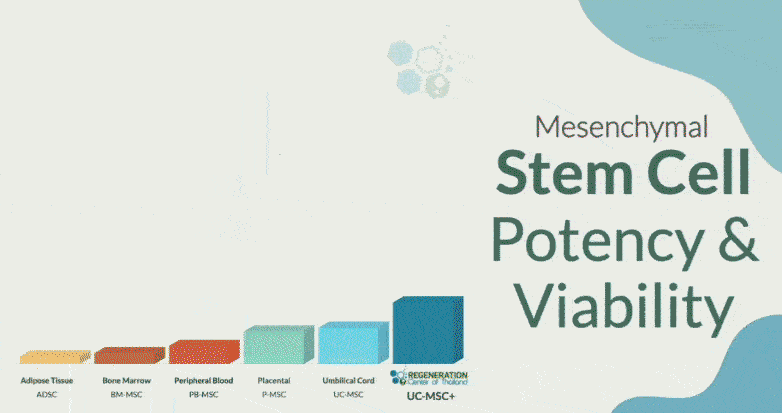For individuals suffering from Osteoporosis and skeletal disorders, stem cell therapy has become a promising and viable treatment approach in 2025. Enhanced Mesenchymal stem cells are special cells that can treat various medical conditions, including Osteoporosis and skeletal disorders. Stem cells can be derived from adult or embryonic sources to repair, regenerate, and replace damaged or missing tissue. The traditional therapeutic methods used in the past for Osteoporosis can usually only prevent bone mass loss but only partially recover the bone.[1]
Bone & Cartilage Diseases
Diseases of the skeletal system are pretty standard for the elderly population and are generally considered to be one of the primary causes of physical disability and morbidity. The most common diseases of the skeletal system include:
- Osteoporosis
- Sarcopenia
- Bone fractures
- Osteoarthritis (OA)
- Rheumatoid arthritis (RA)
- Femoral cartilage degeneration
- Intervertebral disc disease (IVD)
- Lumbar Spinal Stenosis
- Degenerative Disc Disease (DDD)
- Osteogenesis imperfecta (OI) [2]
Stem cell therapy in treating Osteoporosis and skeletal disorders is still in its early stages. However, research has shown that isolating stem cells can help contain the disease, reduce pain, improve mobility, and even increase the strength of bones affected by Osteoporosis. In addition, it has been found that stem cell therapy can help reduce the risk of hand and wrist fractures in patients with Osteoporosis.
Stem Cell Treatment for Osteoporosis
The Regeneration Center offers a unique protocol using isolated and expanded stem cells to treat Osteoporosis. This safe new therapeutic strategy can increase osteoblast differentiation and reverse the previous shift towards bone resorption in patients with mild to moderate Osteoporosis. Cell therapy and regenerative medicine have the potential to bring back the structure and function of normal tissues.
Stem cell-based therapy focuses on chronic illnesses like Osteoporosis. As we age, people can have reduced bone mass or skeletal tissue atrophy, increasing the risk of osteoporotic fractures. This characterizes Osteoporosis as one of the significant causes of morbidity in older men and post-menopausal women. The most frequent and traditional treatment options for Osteoporosis only stop further bone thinning and partially restore bone mass.[3]
Bone Regeneration Therapy
Stem cell-based therapies offer a novel strategy for regenerating bone tissue. By isolating specific populations of mesenchymal stem cells, we can harness their natural anti-inflammatory, immune-privileged potential without ethical concerns compared to other types of stem cells, such as embryonic cells. These cells are vital components in regenerative medicine, especially bone regeneration. According to several published studies, the secretory function of mesenchymal stem cells has a significant role in their effectiveness.
Indeed, they can start particular molecular signaling pathways, which can contribute to the formation of normal bone remodeling.[4]
Osteoporosis is a long-term, chronic skeletal condition that is more prevalent among older people. Therefore, reduced bone mass and mineral density are often to blame for most elderly having fractures. Additionally, osteoporosis is said to be caused by an imbalance in bone cells. It is characterized by low bone mass and microstructural degradation of bone tissue, which increases bone fragility and fracture risk. Compared to other portions of the bone, the proximal ends of the humerus and femur, the distal end of the radius, and the vertebral column are more prone to osteoporotic fractures. In addition, hip fractures are a significant catalyst of death and high morbidity rates. In recent years, stem cell therapies have attracted considerable attention to the field of tissue engineering and regenerative medicine to treat various disorders and degenerative orthopedic issues such as DDD lower back pain, knee injuries, shoulder injuries, spinal injuries, and osteoarthritis.
Stem Cells’ Role in Osteoporosis & Bone Remodeling
Osteoporosis is a complex illness with both endogenous and external components. By reducing fracture susceptibility, enhancing lost mineral density, and modulating bone resorption, MSCs+ stem cells can be incredibly helpful in containing and reversing osteoporosis symptoms.
The treatment works by raising the quantity of progenitor stem cells and enhancing their capacity for cell division and differentiation into bone-forming cells. Stem cells, especially enhanced MSC+ stem cells, can support bone regeneration by secreting bioactive molecules such as IGF-1, TGF-, vascular endothelial growth factor (VEGF), angiogenin, hepatocyte growth factor (HGF), and IL-6. This is because local signals from different cytokines and growth factors can control the bone tissue repair cascade by inducing osteoprogenitor cell migration, cell differentiation, proliferation, revascularization, and extracellular spaces. Exosomes produced by MSCs are additional elements whose effects on halting bone loss and fostering bone remodeling processes (during osteogenesis, osteoclastogenesis, and angiogenesis) have been proven in clinical settings.
Stop Osteoporosis with Mesenchymal Stem Cells
For patients diagnosed with Osteoporosis, endogenous MSC function is diminished as we age, reducing its ability to proliferate, differentiate, and induce bone formation. Stem Cells from umbilical cord tissue (UC-MSC) and hematopoietic stem cells offer us many advantages in clinical use, including accessibility and ease of harvesting, immunosuppressive effects, the capacity for multi-lineal differentiation (especially the ability to differentiate into osteoblasts), and the absence of any possibility of malignant transformation. Adult stem cells can also be obtained from numerous tissue origins because they are a subset of stromal stem cells. One source of MSC+ cells utilized to treat Osteoporosis is those derived from bone marrow (BM-MSCs), which have a high capacity for osteogenic development. Our research has provided evidence suggesting that altering the molecular processes that control osteoblast development in MSCs will improve the efficacy and dependability of Osteoporosis stem cell treatments.[5]
TREATMENT RISKS & PRECAUTIONS
Please note that not all patients are suitable candidates for treating Osteoporosis with stem cells. Patients with severe bone loss, multiple fractures, significant spinal deformities (scoliosis), or other serious health conditions may not qualify for the recommended treatment protocol.Paracrine Effects on Bone Regeneration
Clinical trials and current stem cell research have shown that MSC+ cells promote paracrine activities, can sustain a regenerative state, and have more therapeutic effects than their ability to differentiate. To put it another way, MSC transplantation has ushered in a new era of targeted therapies for Osteoporosis, specifically through paracrine effects of mesenchymal cells. By secreting bioactive growth factors like Insulin-like growth factor 1 (IGF-1), Transforming growth factor (TGF-), Vascular Endothelial Growth Factor (VEGF), Hepatocyte Growth Factor (HGF), Interleukin-6 (IL-6), and Fibroblast Growth Factor, Mesenchymal Stem Cells (MSCs) can aid in bone repair (FGF) much more effectively.
The Regeneration Center Osteoporosis Protocol
Total Number of Stem Cell Infusions: The total number of Endogenous Mesenchymal Stem cells and exosome growth factors will vary based on patient needs. Depending on the injury requirements, the treatment infusions can be done via a Guided Radiograph (when necessary) through an Intravenous Drip, Direct injection, or Intrathecally.[6]
Rehabilitation Post Treatment: Physical Rehabilitation in Bangkok is optional but highly recommended. Complete physical rehab services post-therapy can be provided upon request for 2-3 hours per day and up to 5 days per week.
Total Treatment Time Required is estimated to be 2-3 weeks (depending on the type and seriousness of the condition). Medical and travel visas for extended accommodations at a hotel or apartment for the patient and family can also be provided upon request.
Osteoporosis Treatment Guidelines & Requirements 2025
MSC+ Stem Cell treatment for Osteoporosis will require approximately 1-2 weeks. Due to the varying degrees of severity, our medical team will need to evaluate potential patients to establish an appropriate protocol. Upon completion of the therapy evaluation, a detailed treatment plan will be provided that will include the specifics, such as the exact total number of days required, along with the total medical-related costs.
Stem cell therapy for osteoporosis and skeletal disorders is not appropriate or effective in all cases and conditions, but it has shown promising results. To learn more about the safe and effective MSC+ Stem Cell treatment for Osteoporosis, please contact us today.
Published Clinical Citations
[1] ^ Hu L, Yin C, Zhao F, Ali A, Ma J, Qian A. Mesenchymal Stem Cells: Cell Fate Decision to Osteoblast or Adipocyte and Application in Osteoporosis Treatment. Int J Mol Sci. 2018 Jan 25;19(2):360. doi: 10.3390/ijms19020360. PMID: 29370110; PMCID: PMC5855582.
[2] ^ Li Y, Jin D, Xie W, Wen L, Chen W, Xu J, Ding J, Ren D, Xiao Z. Mesenchymal Stem Cells-Derived Exosomes: A Possible Therapeutic Strategy for Osteoporosis. Curr Stem Cell Res Ther. 2018;13(5):362-368. doi: 10.2174/1574888X13666180403163456. PMID: 29623851.
[3] ^ Aghebati-Maleki L, Dolati S, Zandi R, Fotouhi A, Ahmadi M, Aghebati A, Nouri M, Kazem Shakouri S, Yousefi M. Prospect of mesenchymal stem cells in therapy of Osteoporosis: A review. J Cell Physiol. 2019 Jun;234(6):8570-8578. doi: 10.1002/jcp.27833. Epub 2018 Nov 29. PMID: 30488448.
[4] ^ Rudiansyah M, El-Sehrawy AA, Ahmad I, Terefe EM, Abdelbasset WK, Bokov DO, Salazar A, Rizaev JA, Muthanna FMS, Shalaby MN. Osteoporosis treatment by mesenchymal stromal/stem cells and their exosomes: Emphasis on signaling pathways and mechanisms. Life Sci. 2022 Oct 1;306:120717. doi: 10.1016/j.lfs.2022.120717. Epub 2022 Jul 2. PMID: 35792178.
[5] ^ Aswamenakul K, Klabklai P, Pannengpetch S, Tawonsawatruk T, Isarankura-Na-Ayudhya C, Roytrakul S, Nantasenamat C, Supokawej A. Proteomic study of in vitro osteogenic differentiation of mesenchymal stem cells in high glucose condition in Thailand. Mol Biol Rep. 2020 Oct;47(10):7505-7516. doi: 10.1007/s11033-020-05811-x. Epub 2020 Sep 11. PMID: 32918125.


